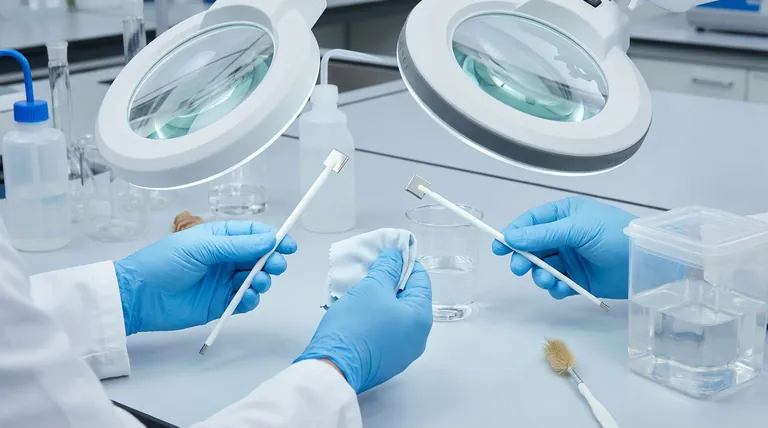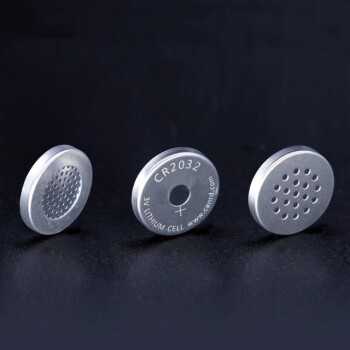The short answer is that proper electrode maintenance centers on two key activities: regular, careful inspection for damage or contamination, and protecting the electrode from prolonged exposure to air, water, or other damaging substances.
An electrode is a sensitive instrument whose performance directly impacts the quality of your data. Viewing maintenance not as a chore, but as a critical part of the measurement process, is the key to ensuring accuracy, reliability, and a long operational life.

The Core Principles of Electrode Maintenance
The goal of any maintenance routine is to preserve the electrode's active surface and internal chemistry. All best practices are designed to prevent the physical and chemical changes that degrade performance over time.
Why Regular Inspection is Crucial
You must regularly inspect the electrode's surface. Look for any physical damage, such as scratches or cracks, which can alter its electrochemical properties.
Also, check for any signs of contamination. A film, residue, or discoloration on the electrode surface can interfere with measurements, leading to inaccurate or slow-responding readings.
The Impact of Exposure
Electrodes are often designed to exist in a specific chemical environment. Prolonged and unnecessary exposure to other substances can be detrimental.
Leaving an electrode exposed to air can lead to oxidation or drying out of critical components. Similarly, leaving it in pure water can, in some cases, cause essential ions to leach out, compromising its function.
Protecting Against Damage
Beyond chemical exposure, physical integrity is paramount. Always handle electrodes with care to avoid bumps or drops.
When not in use, ensure the electrode is secured and, if applicable, that its sensitive tip is protected by a storage cap containing the appropriate solution.
Common Maintenance Pitfalls to Avoid
Even with the best intentions, common mistakes can shorten an electrode's life or compromise its results. Awareness of these pitfalls is the first step to preventing them.
Assuming All Electrodes Are the Same
Different types of electrodes (e.g., pH, ion-selective, reference) have unique storage and cleaning requirements. Applying a one-size-fits-all maintenance plan is a frequent cause of premature failure.
Aggressive or Improper Cleaning
While cleaning is important, using abrasive materials can create scratches that permanently damage the electrode's surface. Using incompatible chemical cleaners can also degrade the electrode body or its sensitive membrane.
Neglecting the Cable and Connector
The maintenance focus is often on the electrode tip, but the cable and connector are also potential points of failure. Inspect the cable for fraying and keep the connector clean and dry to ensure a stable electrical signal.
A Practical Maintenance Checklist
Your specific actions will depend on your equipment, but a consistent strategy is key. Use these points to guide your routine.
- If your primary focus is day-to-day accuracy: Make inspection and, if necessary, cleaning a mandatory step before each set of measurements.
- If your primary focus is extending electrode lifespan: Prioritize correct storage in the manufacturer-recommended solution immediately after use.
- If you are troubleshooting inconsistent readings: Always begin with a thorough inspection and cleaning, as surface contamination is the most common source of error.
Ultimately, proactive maintenance is the foundation of trustworthy and repeatable measurements.
Summary Table:
| Maintenance Activity | Key Purpose | Common Pitfall to Avoid |
|---|---|---|
| Regular Inspection | Check for physical damage (scratches, cracks) and surface contamination. | Assuming all electrode types have the same requirements. |
| Proper Cleaning | Remove residue or film that causes inaccurate readings. | Using abrasive materials or incompatible chemical cleaners. |
| Correct Storage | Protect from air/water exposure to prevent drying or leaching. | Leaving the electrode exposed or storing it in pure water. |
| Cable & Connector Care | Ensure a stable electrical signal and connection. | Neglecting to inspect for fraying or keeping connectors wet. |
Ensure the accuracy and longevity of your laboratory's electrodes. Proper maintenance is critical for reliable data, but having the right equipment from the start is just as important. KINTEK specializes in high-quality lab equipment and consumables, serving all your laboratory needs.
Contact our experts today to discuss your specific requirements and discover how our reliable electrodes and support can enhance your measurement processes and protect your investment.
Visual Guide

Related Products
- Platinum Sheet Electrode for Laboratory and Industrial Applications
- Li-Air Battery Case for Battery Lab Applications
- Custom PTFE Teflon Parts Manufacturer for PTFE Buchner Funnel and Triangular Funnel
- 1200℃ Split Tube Furnace with Quartz Tube Laboratory Tubular Furnace
- Laboratory Quartz Tube Furnace Tubular RTP Heating Furnace
People Also Ask
- What are the available specifications for platinum sheet electrodes? Find the Perfect Fit for Your Electrochemical Needs
- What precautions should be taken when using a platinum sheet electrode? Ensure Accurate & Reproducible Electrochemical Data
- How should a platinum sheet electrode be pretreated before use? Ensure Accurate Electrochemical Measurements
- What is the proper post-treatment procedure for a platinum sheet electrode? Ensure Long-Term Accuracy & Protect Your Investment
- What are the performance characteristics of platinum sheet electrodes? Unlock Superior Electrochemical Performance



















